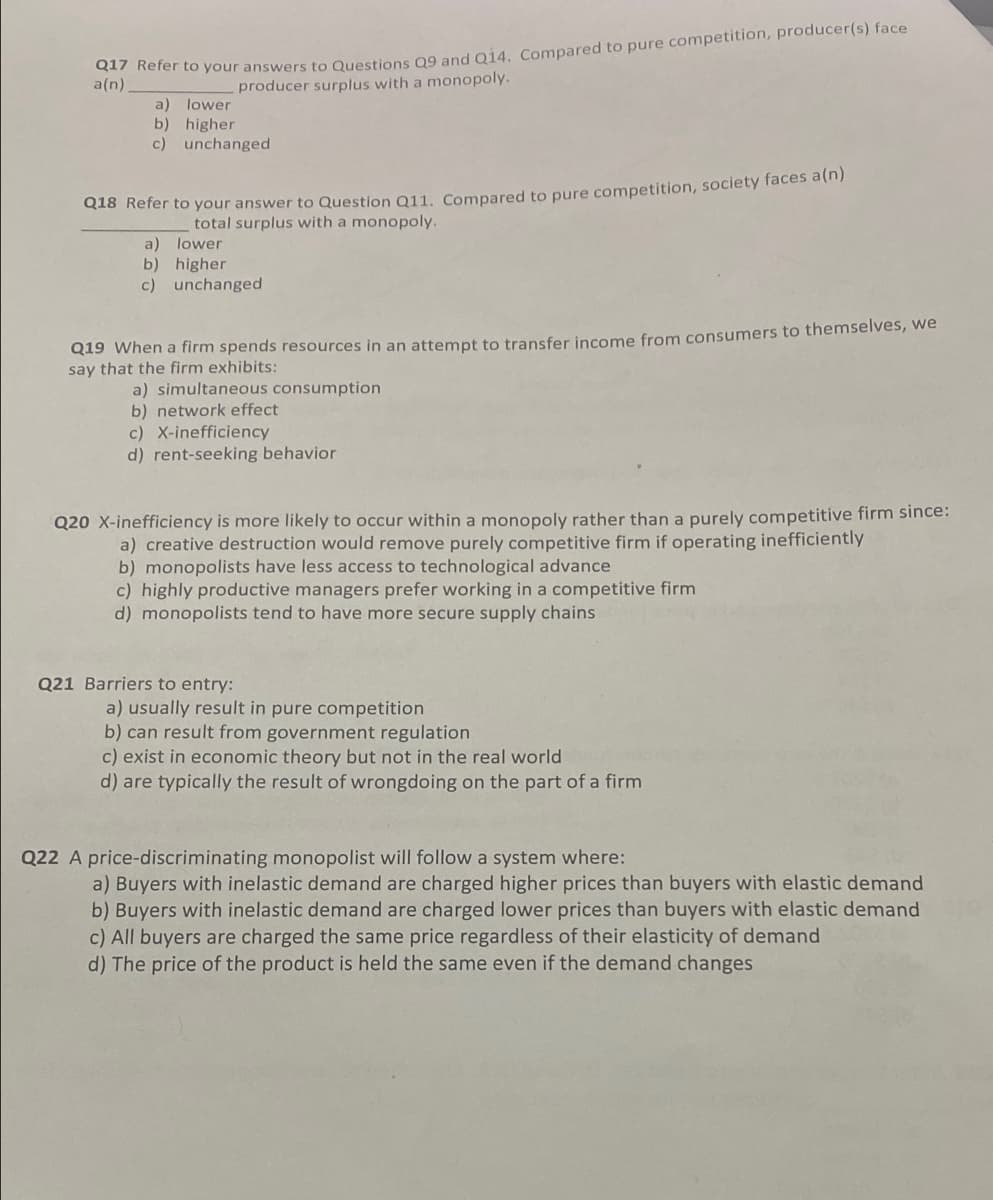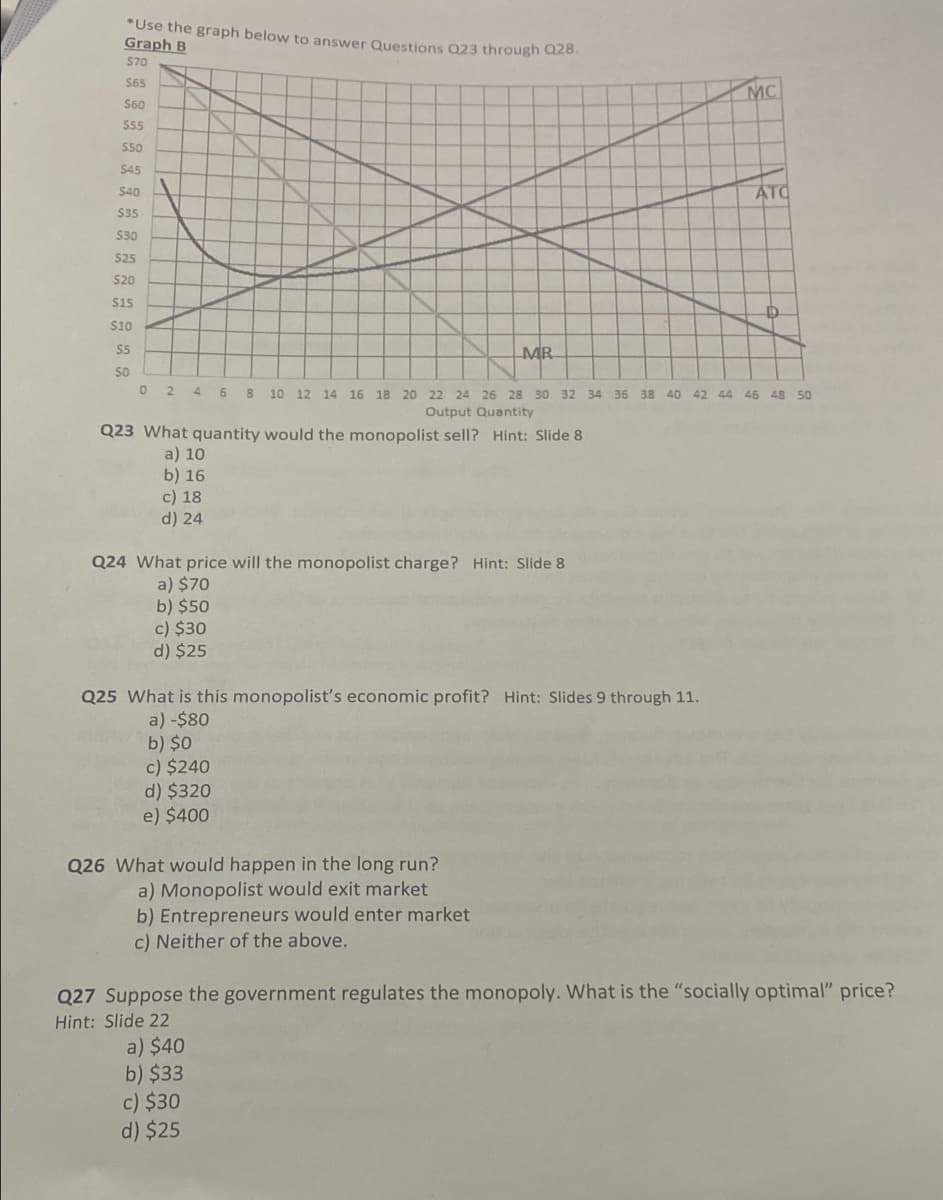antity Q23 What quantity would the monopolist sell? Hint: Slide 8 a) 10 b) 16 c) 18 d) 24 Q24 What price will the monopolist charge? Hint: Slide 8 a) $70 b) $50 c) $30 d) $25 Q25 What is this monopolist's economic profit? Hint: Slides 9 through 11. a) -$80 b) $0 c) $240 d) $320 el $400
antity Q23 What quantity would the monopolist sell? Hint: Slide 8 a) 10 b) 16 c) 18 d) 24 Q24 What price will the monopolist charge? Hint: Slide 8 a) $70 b) $50 c) $30 d) $25 Q25 What is this monopolist's economic profit? Hint: Slides 9 through 11. a) -$80 b) $0 c) $240 d) $320 el $400
Managerial Economics: Applications, Strategies and Tactics (MindTap Course List)
14th Edition
ISBN:9781305506381
Author:James R. McGuigan, R. Charles Moyer, Frederick H.deB. Harris
Publisher:James R. McGuigan, R. Charles Moyer, Frederick H.deB. Harris
Chapter13: best-practice Tactics: Game Theory
Section: Chapter Questions
Problem 1E
Related questions
Question
Need answers to all questions

Transcribed Image Text:a(n)
producer surplus with a monopoly.
a) lower
b) higher
c) unchanged
Cao Rerer to your answer to Question Q11, Compared to pure competition, society faces a(n)
total surplus with a monopoly.
a) lower
b) higher
c) unchanged
Q19 When a firm spends resources in an attempt to transfer income from consumers to themselves, we
say that the firm exhibits:
a) simultaneous consumption
b) network effect
c) X-inefficiency
d) rent-seeking behavior
Q20 X-inefficiency is more likely to occur within a monopoly rather than a purely competitive firm since:
a) creative destruction would remove purely competitive firm if operating inefficiently
b) monopolists have less access to technological advance
c) highly productive managers prefer working in a competitive firm
d) monopolists tend to have more secure supply chains
Q21 Barriers to entry:
a) usually result in pure competition
b) can result from government regulation
c) exist in economic theory but not in the real world
d) are typically the result of wrongdoing on the part of a firm
Q22 A price-discriminating monopolist will follow a system where:
a) Buyers with inelastic demand are charged higher prices than buyers with elastic demand
b) Buyers with inelastic demand are charged lower prices than buyers with elastic demand
c) All buyers are charged the same price regardless of their elasticity of demand
d) The price of the product is held the same even if the demand changes

Transcribed Image Text:*Use the graph below to answer Questions Q23 through Q26.
Graph B
S70
S65
MC
$60
$55
$50
$45
ATO
S40
$35
$30
S25
S20
$15
S10
S5
MR
SO
0 2 4 6 8 10 12 14 16 18 20 22 24 26 28 30 32 34 36 38 40
42 44 46 48 50
Output Quantity
Q23 What quantity would the monopolist sell? Hint: Slide 8
a) 10
b) 16
c) 18
d) 24
Q24 What price will the monopolist charge? Hint: Slide 8
a) $70
b) $50
c) $30
d) $25
Q25 What is this monopolist's economic profit? Hint: Slides 9 through 11.
a) -$80
b) $0
c) $240
d) $320
e) $400
Q26 What would happen in the long run?
a) Monopolist would exit market
b) Entrepreneurs would enter market
c) Neither of the above.
Q27 Suppose the government regulates the monopoly. What is the "socially optimal" price?
Hint: Slide 22
a) $40
b) $33
c) $30
d) $25
Expert Solution
This question has been solved!
Explore an expertly crafted, step-by-step solution for a thorough understanding of key concepts.
Step by step
Solved in 4 steps

Knowledge Booster
Learn more about
Need a deep-dive on the concept behind this application? Look no further. Learn more about this topic, economics and related others by exploring similar questions and additional content below.Recommended textbooks for you

Managerial Economics: Applications, Strategies an…
Economics
ISBN:
9781305506381
Author:
James R. McGuigan, R. Charles Moyer, Frederick H.deB. Harris
Publisher:
Cengage Learning

Managerial Economics: Applications, Strategies an…
Economics
ISBN:
9781305506381
Author:
James R. McGuigan, R. Charles Moyer, Frederick H.deB. Harris
Publisher:
Cengage Learning